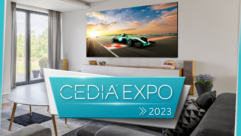
Commercial Versus Consumer Grade: Pay Close Attention to Display Specs
Apr 28, 2009 12:00 PM,
By John W. DeWitt

The entry of HP, with products such as the LD4200 42in. widescreen digital signage LCD monitor, and other large IT players signals a healthy digital-signage marketplace, according to DisplaySearch analyst Chris Connery.
Growth forecasts for the digital signage marketplace remain bullish, according to analyst Chris Connery, vice president for PC and large-format commercial displays at DisplaySearch. “Our forecasts are revised down a little bit, but we still see 2009 as a good year, with year-over-year growth, which most areas of information technology cannot say,” Connery said in a recent interview with Digital Signage Update. “Digital signage is still a bright spot in the overall IT and AV marketplace.”
The entrance of large players—notably Cisco, HP, and FastSigns—provides further indication of the health of the market and creates opportunities for value-added resellers (VARs), he adds, noting that Cisco and HP “both are very VAR and channel friendly.”
Still, despite the growth market, digital-signage integrators and users may face pressure to trim costs by implementing lower-grade displays, so Connery emphasizes in the following Q#amp;A discussion that integrators and their customers need to pay close attention to the technical specifications behind the display’s brand.
SVC: There are a more choices than ever in terms of available displays. What should AV integrators and their users pay attention to?
Connery: Commercial versus consumer-grade products—display manufacturers will be talking about that a lot at InfoComm and other trade shows this year. A lot of the big panel manufacturers are associated with their own brands; conversely, a company like NEC doesn’t have any core production in LCDs, but is number one or two in terms of LCD digital signage. So it’s important for integrators to understand the core technology behind the screen and brand name. It’s not just that the NEC display is using a panel from LG Displays—that’s not the important point—but it’s which panel from LG? LG has a lineup of panels specifically designed for 24-hour usage seven days a week. Major panel manufacturers are now offering several grades of panels.
As an example, Samsung makes panels for its own brand and for other manufacturers. Cisco would use Samsung as a source. Samsung has consumer-grade TV panels, and now it has even subsegmented its panel roadmap for Digital Information Display panels (DIDs), and Samsung has a couple of different derivations for those. Samsung’s segmentation makes it easy to talk about its displays. You need to pay attention to commercial-grade panels and to their segmentation. For instance, Samsung has a B basic DID panel and a P performance panel.
Likewise there are other panel manufacturers such as Sony, LG Displays, and AUO, a Taiwanese panel manufacturer with no brand presence here. Each has panels that are specifically designed to be used in a commercial digital-signage environment. An informed VAR really needs to understand and be able to explain to his or her customer what the differences are.
Commercial Versus Consumer Grade: Pay Close Attention to Display Specs
Apr 28, 2009 12:00 PM,
By John W. DeWitt
What are some of the differences that matter when selecting display panels?
Some of the differences are that commercial-grade panels would be sealed so that dust and contaminants can’t get in there. They would have a different backlight structure so it can be used in either portrait or landscape mode. Many larger than 46in. panels have issues if you simply turn them on their side to use in portrait mode. Sharp, for example, offers a landscape-only and portrait-only model. If a VAR takes a 55in. TV and turns it on its side, he or she will run into problems later.
Each of these panel manufacturers has a little something different about what makes theirs commercial grade versus another company’s commercial grade. You have to understand from a panel standpoint, not just from the name that’s on the bezel.
A good easy way to quickly tell is warranty. Usually consumer-grade products have a one-year warranty. Any commercial-grade product will have at least a three-year warranty, and it will have a three-year warranty 24 hours a day, seven days a week.
So does the brand on the outside still matter?
The name that’s on the bezel is another thing. That’s who the VAR will be interfacing with, so it matters too. But an educated VAR will ask what type of panel is being used in the solution.
For more information, visit www.displaysearch.com.










